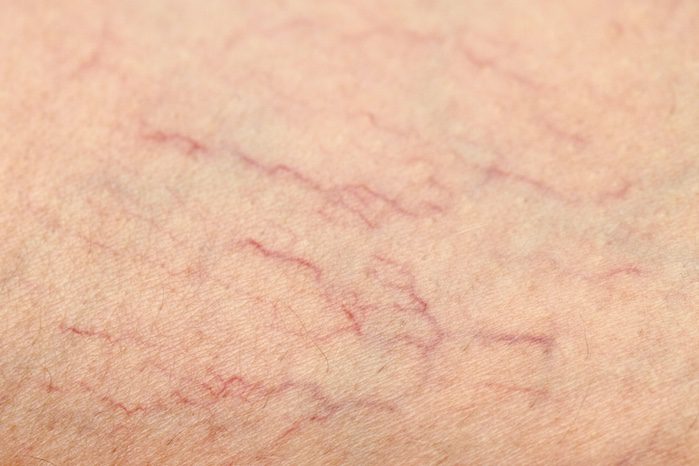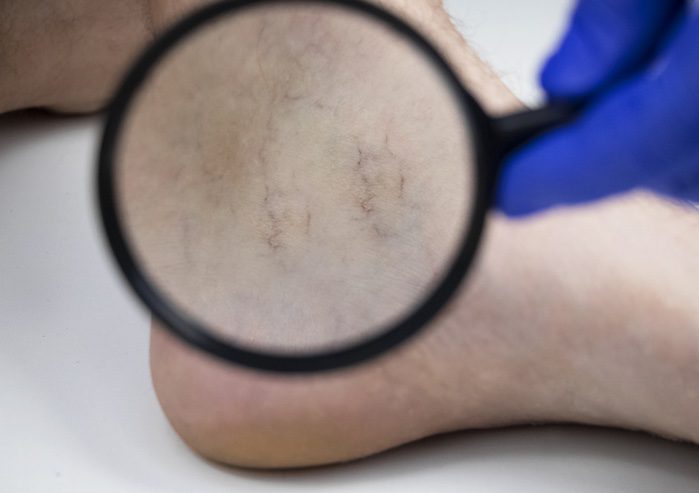Varicose To Perfect is one of the most comprehensive centers in the Cincinnati-Dayton area for the treatment of spider veins. Our team is led by a board-certified physician, Dr. Sukir Sinnathamby, a specialist in vein conditions.

Spider Veins vs. Varicose Veins
Doctors consider spider veins a mild form of venous insufficiency and typically occur in middle-aged women and men. Sun exposure, excess pressure, or hormonal changes often cause and worsen Spider veins.
Spider veins are similar to varicose veins – though they are smaller and exist much closer to the surface of the skin. Moreover, they are dilated capillaries that appear as star-burst or web-shaped clusters on the legs or face.
Although doctors don’t normally consider it a threat to individual health, many people undergo spider vein treatment to remove these unsightly cosmetic blemishes.
What Causes Spider Veins?
Spider veins, the thin, web-like blood vessels visible just beneath the skin, are a common concern for many. While they are often harmless, understanding their causes can help with prevention and treatment.
1. Weak or Damaged Vein Valves
Veins carry blood back to the heart, using one-way valves to prevent backflow. When these valves weaken or become damaged, blood can pool in the veins, causing them to swell and become visible. This process, known as venous insufficiency, is a primary cause of spider veins.
2. Genetics
A family history of spider or varicose veins significantly increases your likelihood of developing them. Genetics can influence the strength of your vein walls and valves, making them more prone to dysfunction.
3. Hormonal Changes
Hormonal fluctuations, especially in women, are a common trigger for spider veins. Events like:
- Puberty
- Pregnancy
- Menopause
These changes can weaken vein walls or increase blood flow, causing veins to dilate. Medications like birth control pills or hormone replacement therapy can also heighten the risk.
4. Prolonged Standing or Sitting
Jobs or activities requiring extended periods in one position—standing or sitting—can slow blood flow in the legs. This stagnation increases vein pressure, contributing to spider veins. Occupations like teaching, retail, or desk jobs are particularly linked to this risk factor.
5. Pregnancy
Pregnancy exerts extra strain on the body’s circulatory system. Contributing factors include:
- Increased blood volume to support the baby
- Hormonal changes that relax vein walls
- Added pressure from the growing uterus on leg veins
Spider veins often appear during pregnancy, although they may fade after delivery.
6. Sun Damage
Excessive exposure to sunlight can weaken blood vessels near the skin’s surface, particularly on the face. This damage increases the visibility of veins and contributes to spider vein formation, especially in fair-skinned individuals.
7. Obesity
Excess weight places additional pressure on leg veins, making it harder for blood to flow efficiently. Over time, this increased strain weakens vein walls and valves, leading to spider veins.
8. Injury or Trauma
Physical injuries, surgeries, or trauma to the skin can damage underlying blood vessels. This damage can cause veins to become more visible, resulting in spider veins.
9. Aging
As we age, vein walls naturally lose elasticity, and valves become less effective at preventing backflow. This decline in vein function makes spider veins more common in older adults.
10. Lifestyle Habits
Certain habits and choices can also contribute to spider veins:
- Wearing tight clothing or high heels, which restrict blood flow
- Leading a sedentary lifestyle with minimal physical activity
Both can impair circulation and increase the likelihood of developing spider veins.
Risk Factors for Spider Veins
Certain factors increase the likelihood of developing spider veins, including:
- Gender: Women are more likely to develop spider veins than men due to hormonal changes.
- Age: The risk of spider veins increases as veins weaken over time.
- Family History: Genetics plays a major role in developing spider veins.
- Lifestyle: Jobs or habits that involve prolonged standing or sitting can lead to spider veins.
- Weight: Being overweight or obese increases vein pressure, contributing to spider veins.
- Sun Exposure: Excessive sun exposure, especially for fair-skinned individuals, raises the risk of spider veins on the face.
Symptoms of Spider Veins
For many people, spider veins are purely a cosmetic concern. However, in some cases, they can cause mild discomfort or indicate more serious vein problems. Common symptoms include:
- Visible Veins: Thin, web-like veins that are red, blue, or purple.
- Swelling: Slight swelling in the affected area.
- Aching or Burning: Some people experience mild pain or a burning sensation in the area around spider veins.
- Heaviness in the Legs: A feeling of heaviness or fatigue in the legs, especially after standing for long periods.
- Itching: Spider veins may cause the skin to feel itchy.
If spider veins are accompanied by significant pain, swelling, or discoloration, it could indicate a more serious condition like chronic venous insufficiency or deep vein thrombosis.
How To Get Rid of Spider Veins
Varicose to Perfect is a comprehensive Vein Clinic in Springboro, OH. Dr. Sukir Sinnathamby provides effective, safe, and painless spider vein removal treatments.
Laser Treatment for Spider Veins
Spider vein treatment may vary depending on your condition and aesthetic goals. One of the more common treatments for spider vein removal is laser treatment.
The laser treatment for spider veins is non-invasive. Dr. Sinnathamby uses a special light to target the tiny vessels, causing them to slowly fade and disappear. Typically, you will need multiple sessions for optimal results.
Sclerotherapy
Another treatment for spider veins is Sclerotheraphy. This treatment involves an injection into the affected veins, causing them to close and collapse.
Spider Veins Frequently Asked Questions
Spider veins are a common condition people experience. Read the answers to these commonly asked questions to learn more.
Is laser treatment for spider veins painful?
Most patients don’t consider laser treatment for spider veins painful. The discomfort is usually pretty manageable. Doctors use local anesthesia and sometimes a mild sedative to minimize discomfort.
Some patients might find it slightly uncomfortable but typically don’t describe it as painful. The area might also feel tender or look slightly red afterward, but this doesn’t last long. Most patients go about their day right after the treatment.
Can spider veins go away on their own without treatment?
Unfortunately, spider veins rarely go away without some type of treatment intervention. If you don’t address the underlying blood vessel disruption, they persist and spread progressively more prominent. That’s why we recommend patients with bothersome or worsening spider veins have treatments like sclerotherapy to reduce them.
Are spider veins the same as varicose veins?
Spider veins and varicose veins are similar but not the same. They differ in size, location, and appearance. Spider veins are small and close to the surface of the skin. They are often red or blue and can look like tree branches or spider webs.
Varicose veins, on the other hand, are larger, bulging, twisted, and can cause discomfort. You can see varicose veins beneath the skin, and they often require treatment due to health concerns.
Are there any side effects of laser treatment for spider veins?
Yes, laser treatment for spider veins can have some side effects. However, the side effects are generally mild and temporary. Common ones include redness, swelling, and bruising at the treatment site.
You might also experience itching or slight skin discoloration. But this usually fades over time. There are also rare instances of blistering or changes in skin texture. You should follow your healthcare provider’s aftercare instructions to minimize any side effects.
What deficiency causes spider veins?
Spider veins don’t typically cause a nutritional deficiency. They’re more often related to genetics, hormonal changes, age, and lifestyle habits. However, certain nutritional deficiencies can indirectly affect vein health. For instance, Vitamin C and Vitamin K deficiencies can impact the strength and elasticity of blood vessels.
Also, a lack of bioflavonoids, found in fruits and vegetables, may weaken capillaries. Eating a balanced diet to support your overall health is always a good idea. However, specific nutritional deficiencies aren’t usually the direct cause of spider veins.
Who is more likely to develop spider veins?
Aging is a significant factor in developing spider veins. Genetics also play a role, with a family history of spider veins increasing the likelihood of developing spider veins.
Women have a higher risk of getting it due to hormonal changes, such as those occurring during pregnancy, puberty, or menopause. Other risk factors include a sedentary lifestyle, obesity, and prolonged standing or sitting.

